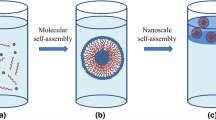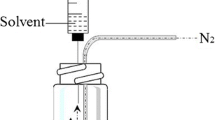Abstract
A pressurized liquid extraction (PLE) method was developed for melamine analysis in pet foods. The PLE method which utilized an accelerated solvent extraction (ASE®) system was also compared with sonication and polytron extraction methods. The parameters for the optimized PLE method were temperature (75 °C for wet pet food, 125 °C for dry pet food), pressure (1,500 psi), static time (10 min), flush volume (40%), purge time (1 min), and number of cycles (1). Recoveries obtained by PLE method were significantly higher (P ≤ 0.05) than those of sonication and polytron methods for dry pet food samples. For the analysis of adulterated pet foods, PLE resulted in the highest melamine content followed by sonication and polytron. Using PLE, samples fortified with melamine at 2.5 and 100 mg kg−1 resulted in recoveries ranging from 55% to 90% for wet samples and from 90% to 116% for dry samples. Low recovery rate from wet samples at low spike level (2.5 mg kg−1) may have been caused by co-aggregation of polysaccharide and protein with melamine due to low pH during solid-phase extraction cleanup. Limit of detection and limit of quantification values were 0.5 (mg kg−1) and 1.0 (mg kg−1) for dry samples. Overall, PLE had the best extraction efficiency compared to sonication and polytron, proving PLE to be a useful tool for melamine analysis of pet foods.



Similar content being viewed by others
References
Andersen WC, Turnipseed SB, Karbiwnyk CM, Clark SB, Madson MR, Gieseker CM, Miller RA, Rummel NG, Reimschuessel R (2008) Determination and confirmation of melamine residues in catfish, trout, tilapia, salmon, and shrimp by liquid chromatography with tandem mass spectrometry. J Agric Food Chem 56:4340–4347
Cianciolo RE, Bischoff K, Ebel JG, Van Winkle TJ, Goldstein RE, Serfilippi LM (2008) Clinicopathologic, histologic, and toxicologic findings in 70 cats inadvertently exposed to pet food contaminated with melamine and cyanuric acid. J Am Vet Med Assoc 233:729–737
Ehling S, Tefera S, Ho IP (2007) High-performance liquid chromatographic method for the simultaneous detection of the adulteration of cereal flours with melamine and related triazine by-products ammeline, ammelide, and cyanuric acid. Food Addit Contam 24:1319–1325
Filigenzi MS, Tor ER, Poppenga RH, Aston LA, Puschner B (2007) The determination of melamine in muscle tissue by liquid chromatography/tandem mass spectrometry. Rapid Commun Mass Spectrom 21:4027–4032
Filigenzi MS, Puschner B, Aston LS, Poppenga RH (2008) Diagnostic determination of melamine and related compounds in kidney tissue by liquid chromatography/tandem mass spectrometry. J Agric Food Chem 56:7593–7599
Gfrerer M, Chen S, Lankmayr EP, Quan X, Yang F (2004) Comparison of different extraction techniques for the determination of chlorinated pesticides in animal feed. Anal Bioanal Chem 378:1861–1867
Giergielewicz-Mozajska H, Dabrowski L, Namiesnik J (2001) Accelerated solvent extraction (ASE) in the analysis of environmental solid samples—some aspects of theory and practice. Crit Rev Anal Chem 31:149–165
He L, Liu Y, Lin M, Awika J, Ledoux DR, Li H, Mustapha A (2008) A new approach to measure melamine, cyanuric acid, and melamine cyanurate using surface enhanced Raman spectroscopy coupled with gold nanosubstrates. Sens & Instrumen Food Qual 2:66–71
Merck (1989) Merck Index, 11th edn. MERCK, Rahway
Kim B, Perkins LB, Bushway RJ, Nesbit S, Fan T, Sheridan R, Greene V (2008) Determination of melamine in pet food by enzyme immunoassay, high-performance liquid chromatography with diode array detection, and ultra-performance liquid chromatography with tandem mass spectrometry. J AOAC Int 91:408–413
Mendiola JA, Herrero M, Cifuentes A, Ibanez E (2007) Use of compressed fluids for sample preparation: food applications. J Chromatogr A 1152:234–246
Reimschuessel R, Gieseker CM, Miller RA, Ward J, Boehmer J, Rummel N, Heller DN, Nochetto C, de Alwis GK, Bataller N, Andersen WC, Turnipseed SB, Karbiwnyk CM, Satzger RD, Crowe JB, Wilber NR, Reinhard MK, Roberts JF, Witkowski MR (2008) Evaluation of the renal effects of experimental feeding of melamine and cyanuric acid to fish and pigs. Am J Vet Res 69:1217–1228
Smoker M, Krynitsky AJ (2008) Interim method for determination of melamine and cyanuric acid residues in foods using LC–MS/MS: version 1.0. U.S. FDA laboratory information bulletin (4422).
Turnipseed S, Casey C, Nochetto C, Heller DN (2008) Determination of melamine and cyanuric acid residues in infant formula using LC–MS/MS. U.S. FDA laboratory information bulletin 24(4421).
U. S. Food and Drug Administration (2007) GC–MS screen for the presence of melamine, ammeline, ammelide and cyanuric acid (version 2.1). http://www.fda.gov/cvm/gcmsmelamine.htm. Accessed 9 Feb 2009
U. S. Food and Drug Administration (2008a) Center for Food Safety and Applied Nutrition. Pet food recall (melamine)/tainted animal feed. http://www.fda.gov/oc/opacom/hottopics/petfood.html. Accessed 9 Feb 2009
U. S. Food and Drug Administration. (2008b) Center for Food Safety and Applied Nutrition. Interim safety and risk assessment of melamine and its analogues in food for humans. http://www.cfsan.fda.gov/~dms/melamra3.html. Accessed 9 Feb 2009
World Health Organization (2008) Melamine and cyanuric acid: toxicity, preliminary risk assessment and guidance on levels in food. http://www.who.int/foodsafety/fs_management/infosan_events/en/index.html. Accessed 25 Sep 2008
Acknowledgments
This is Maine Agricultural and Forest Experiment Station publication #3074. We thank Dr. Robert Sheridan for providing adulterated pet food samples.
Author information
Authors and Affiliations
Corresponding author
Rights and permissions
About this article
Cite this article
Kim, B., LeBlanc, L.A., Bushway, R.J. et al. Applicability of Pressurized Liquid Extraction for Melamine Analysis in Pet Foods with High-Performance Liquid Chromatography with Diode Array Detection. Food Anal. Methods 3, 188–194 (2010). https://doi.org/10.1007/s12161-009-9112-1
Received:
Accepted:
Published:
Issue Date:
DOI: https://doi.org/10.1007/s12161-009-9112-1




